SKODA ROOMSTER 2014 1.G Manual PDF
Manufacturer: SKODA, Model Year: 2014, Model line: ROOMSTER, Model: SKODA ROOMSTER 2014 1.GPages: 204, PDF Size: 14.15 MB
Page 71 of 204
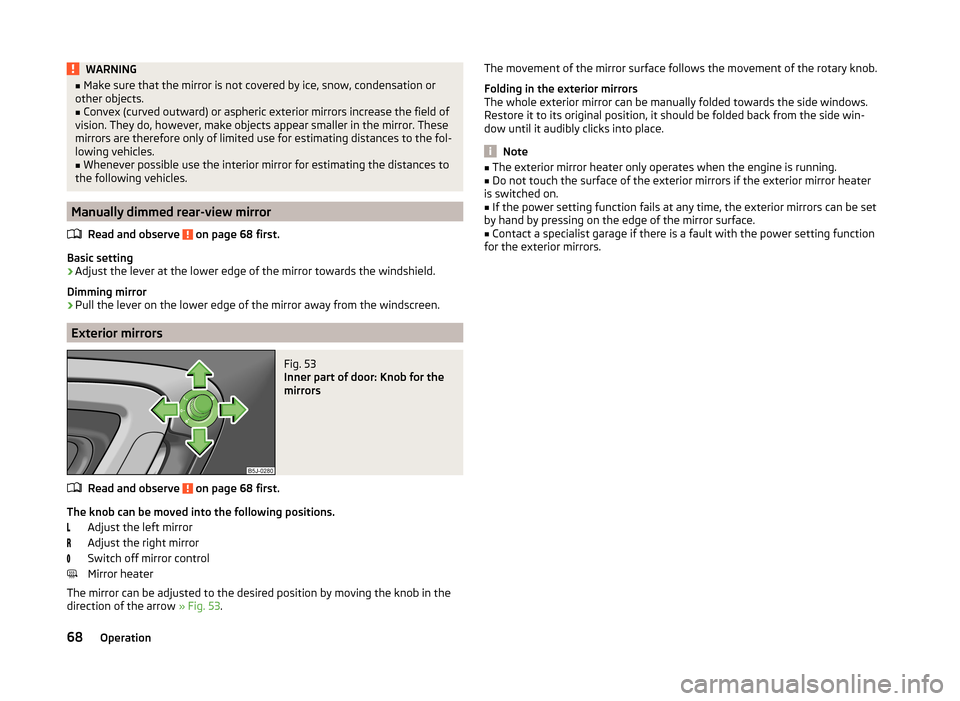
WARNING■Make sure that the mirror is not covered by ice, snow, condensation or
other objects.■
Convex (curved outward) or aspheric exterior mirrors increase the field of
vision. They do, however, make objects appear smaller in the mirror. These
mirrors are therefore only of limited use for estimating distances to the fol-
lowing vehicles.
■
Whenever possible use the interior mirror for estimating the distances to
the following vehicles.
Manually dimmed rear-view mirror
Read and observe
on page 68 first.
Basic setting
›
Adjust the lever at the lower edge of the mirror towards the windshield.
Dimming mirror
›
Pull the lever on the lower edge of the mirror away from the windscreen.
Exterior mirrors
Fig. 53
Inner part of door: Knob for the
mirrors
Read and observe on page 68 first.
The knob can be moved into the following positions.
Adjust the left mirror
Adjust the right mirror
Switch off mirror control
Mirror heater
The mirror can be adjusted to the desired position by moving the knob in the
direction of the arrow » Fig. 53.
The movement of the mirror surface follows the movement of the rotary knob.
Folding in the exterior mirrors
The whole exterior mirror can be manually folded towards the side windows.
Restore it to its original position, it should be folded back from the side win-
dow until it audibly clicks into place.
Note
■ The exterior mirror heater only operates when the engine is running.■Do not touch the surface of the exterior mirrors if the exterior mirror heater
is switched on.■
If the power setting function fails at any time, the exterior mirrors can be set
by hand by pressing on the edge of the mirror surface.
■
Contact a specialist garage if there is a fault with the power setting function
for the exterior mirrors.
68Operation
Page 72 of 204
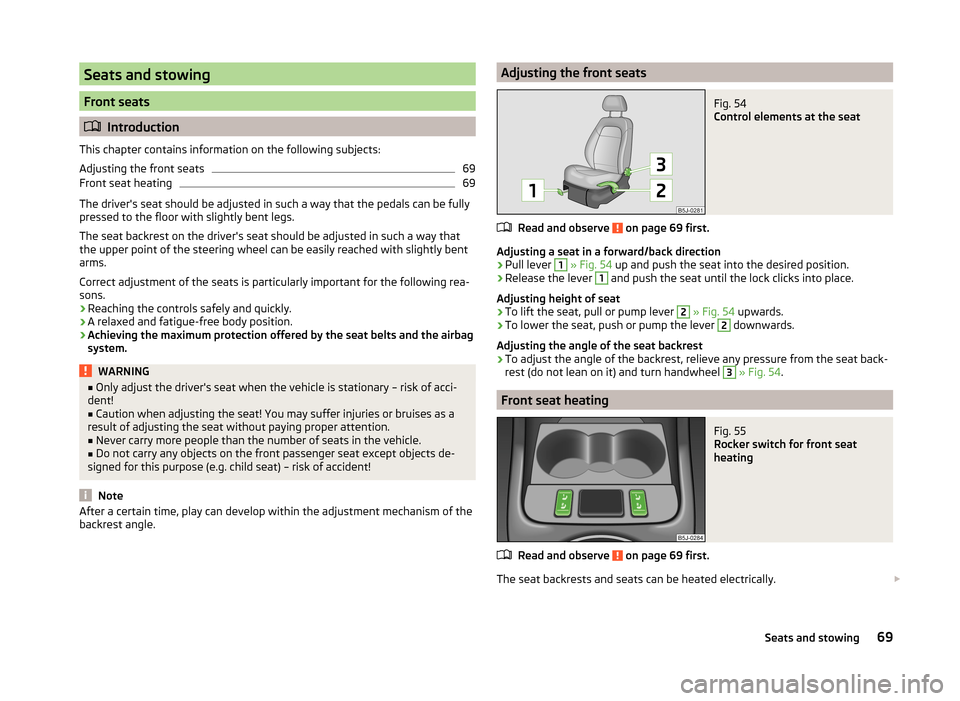
Seats and stowing
Front seats
Introduction
This chapter contains information on the following subjects:
Adjusting the front seats
69
Front seat heating
69
The driver's seat should be adjusted in such a way that the pedals can be fully
pressed to the floor with slightly bent legs.
The seat backrest on the driver's seat should be adjusted in such a way that the upper point of the steering wheel can be easily reached with slightly bent
arms.
Correct adjustment of the seats is particularly important for the following rea-
sons.
› Reaching the controls safely and quickly.
› A relaxed and fatigue-free body position.
› Achieving the maximum protection offered by the seat belts and the airbag
system.
WARNING■ Only adjust the driver's seat when the vehicle is stationary – risk of acci-
dent!■
Caution when adjusting the seat! You may suffer injuries or bruises as a
result of adjusting the seat without paying proper attention.
■
Never carry more people than the number of seats in the vehicle.
■
Do not carry any objects on the front passenger seat except objects de-
signed for this purpose (e.g. child seat) – risk of accident!
Note
After a certain time, play can develop within the adjustment mechanism of the
backrest angle.Adjusting the front seatsFig. 54
Control elements at the seat
Read and observe on page 69 first.
Adjusting a seat in a forward/back direction
›
Pull lever
1
» Fig. 54 up and push the seat into the desired position.
›
Release the lever
1
and push the seat until the lock clicks into place.
Adjusting height of seat
›
To lift the seat, pull or pump lever
2
» Fig. 54 upwards.
›
To lower the seat, push or pump the lever
2
downwards.
Adjusting the angle of the seat backrest
›
To adjust the angle of the backrest, relieve any pressure from the seat back-
rest (do not lean on it) and turn handwheel
3
» Fig. 54 .
Front seat heating
Fig. 55
Rocker switch for front seat
heating
Read and observe on page 69 first.
The seat backrests and seats can be heated electrically.
69Seats and stowing
Page 73 of 204
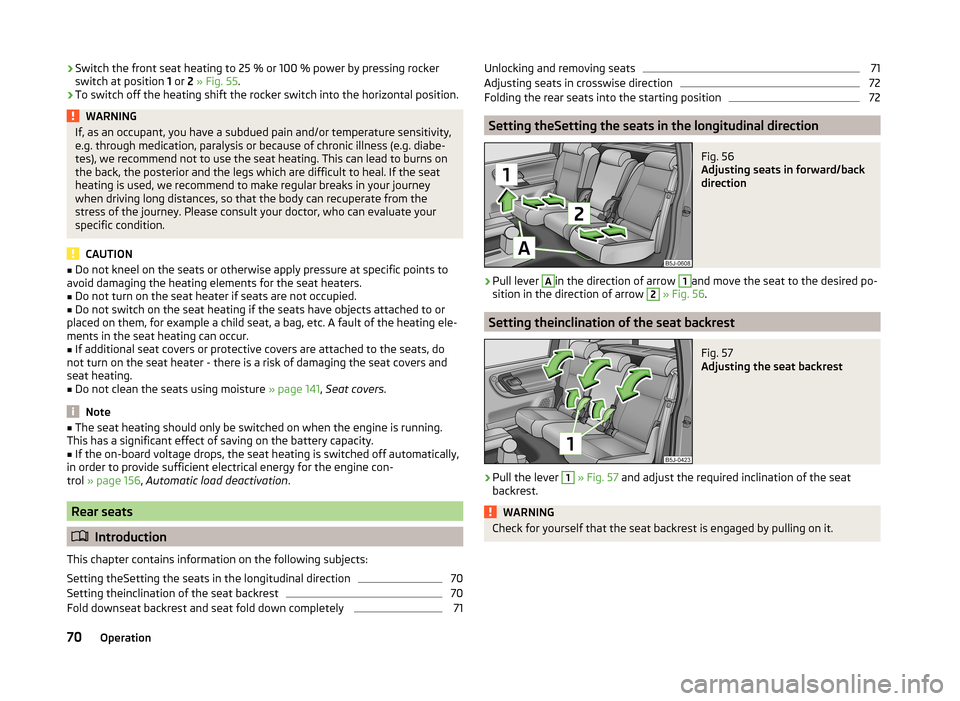
›Switch the front seat heating to 25 % or 100 % power by pressing rocker
switch at position 1 or 2 » Fig. 55 .›
To switch off the heating shift the rocker switch into the horizontal position.
WARNINGIf, as an occupant, you have a subdued pain and/or temperature sensitivity,
e.g. through medication, paralysis or because of chronic illness (e.g. diabe-
tes), we recommend not to use the seat heating. This can lead to burns on
the back, the posterior and the legs which are difficult to heal. If the seat
heating is used, we recommend to make regular breaks in your journey
when driving long distances, so that the body can recuperate from the
stress of the journey. Please consult your doctor, who can evaluate your
specific condition.
CAUTION
■ Do not kneel on the seats or otherwise apply pressure at specific points to
avoid damaging the heating elements for the seat heaters.■
Do not turn on the seat heater if seats are not occupied.
■
Do not switch on the seat heating if the seats have objects attached to or
placed on them, for example a child seat, a bag, etc. A fault of the heating ele-
ments in the seat heating can occur.
■
If additional seat covers or protective covers are attached to the seats, do
not turn on the seat heater - there is a risk of damaging the seat covers and
seat heating.
■
Do not clean the seats using moisture » page 141, Seat covers .
Note
■
The seat heating should only be switched on when the engine is running.
This has a significant effect of saving on the battery capacity.■
If the on-board voltage drops, the seat heating is switched off automatically,
in order to provide sufficient electrical energy for the engine con-
trol » page 156 , Automatic load deactivation .
Rear seats
Introduction
This chapter contains information on the following subjects:
Setting theSetting the seats in the longitudinal direction
70
Setting theinclination of the seat backrest
70
Fold downseat backrest and seat fold down completely
71Unlocking and removing seats71Adjusting seats in crosswise direction72
Folding the rear seats into the starting position
72
Setting theSetting the seats in the longitudinal direction
Fig. 56
Adjusting seats in forward/back
direction
›
Pull lever
A
in the direction of arrow
1
and move the seat to the desired po-
sition in the direction of arrow
2
» Fig. 56 .
Setting theinclination of the seat backrest
Fig. 57
Adjusting the seat backrest
›
Pull the lever
1
» Fig. 57 and adjust the required inclination of the seat
backrest.
WARNINGCheck for yourself that the seat backrest is engaged by pulling on it.70Operation
Page 74 of 204
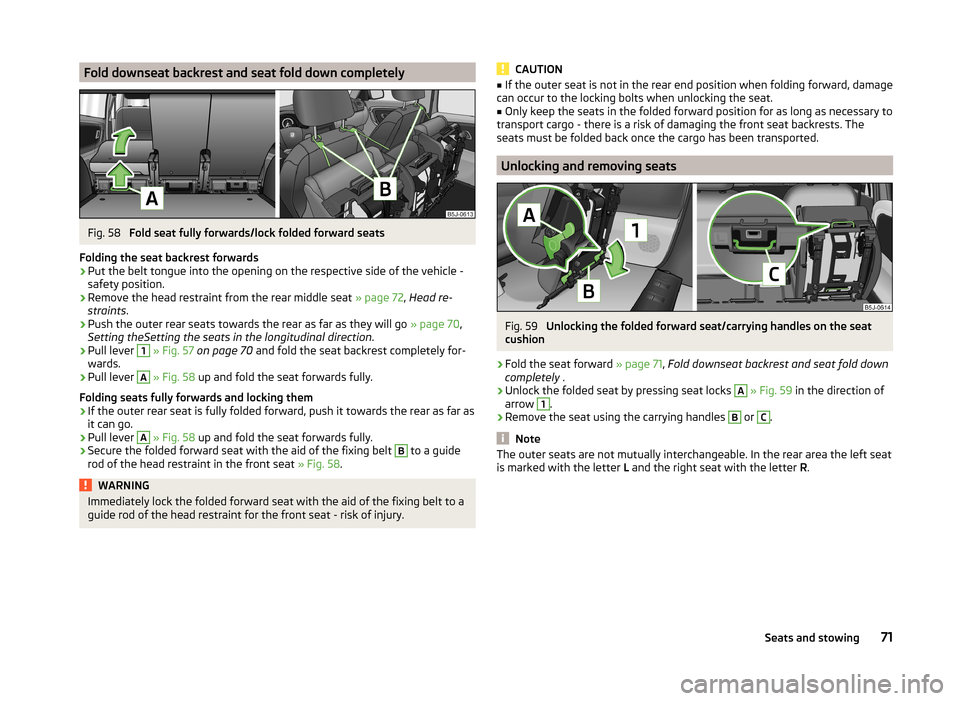
Fold downseat backrest and seat fold down completelyFig. 58
Fold seat fully forwards/lock folded forward seats
Folding the seat backrest forwards
›
Put the belt tongue into the opening on the respective side of the vehicle -
safety position.
›
Remove the head restraint from the rear middle seat » page 72, Head re-
straints .
›
Push the outer rear seats towards the rear as far as they will go » page 70,
Setting theSetting the seats in the longitudinal direction .
›
Pull lever
1
» Fig. 57 on page 70 and fold the seat backrest completely for-
wards.
›
Pull lever
A
» Fig. 58 up and fold the seat forwards fully.
Folding seats fully forwards and locking them
›
If the outer rear seat is fully folded forward, push it towards the rear as far as
it can go.
›
Pull lever
A
» Fig. 58 up and fold the seat forwards fully.
›
Secure the folded forward seat with the aid of the fixing belt
B
to a guide
rod of the head restraint in the front seat » Fig. 58.
WARNINGImmediately lock the folded forward seat with the aid of the fixing belt to a
guide rod of the head restraint for the front seat - risk of injury.CAUTION■ If the outer seat is not in the rear end position when folding forward, damage
can occur to the locking bolts when unlocking the seat.■
Only keep the seats in the folded forward position for as long as necessary to
transport cargo - there is a risk of damaging the front seat backrests. The
seats must be folded back once the cargo has been transported.
Unlocking and removing seats
Fig. 59
Unlocking the folded forward seat/carrying handles on the seat
cushion
›
Fold the seat forward » page 71, Fold downseat backrest and seat fold down
completely .
›
Unlock the folded seat by pressing seat locks
A
» Fig. 59 in the direction of
arrow
1
.
›
Remove the seat using the carrying handles
B
or
C
.
Note
The outer seats are not mutually interchangeable. In the rear area the left seat
is marked with the letter L and the right seat with the letter R.71Seats and stowing
Page 75 of 204

Adjusting seats in crosswise directionFig. 60
Locking seats
›
Remove the middle seat » page 71, Unlocking and removing seats .
›
Fold the outer seat forwards » page 71, Fold downseat backrest and seat
fold down completely and unlock » Fig. 59 on page 71 .
›
Move the folded forward and unlocked seat on the guide towards the middle
of the vehicle up to the stop.
›
Lock the folded seat by pressing seat locks
A
» Fig. 60 in the direction of
the arrow.
Folding the rear seats into the starting position
Fig. 61
Folding the seat backrest back
into position
›
If the seat has been removed, first position it on the guide and lock it in
place » Fig. 60 on page 72 . Pull the seat upwards to ensure that the seat is
locked correctly.
›
Fold the seat in the horizontal position until it can be heard to click. Check for
yourself that the seat can no longer be lifted by pulling it up.
›
Press the lever » Fig. 61 and fold back the seat backrest. Check for yourself
that the seat backrest is engaged by pulling on it.
›
Remove the tongue of the lock from the safety position.
WARNING■ The belt locks must be in their original position after folding back the seat
cushions and backrests - they must be ready to use.■
The seat backrests must be securely latched in position so that no ob-
jects from the luggage compartment can slip into the passenger compart-
ment under sudden braking – there is a risk of injury.
■
When folding the seat backrest always make sure that it has safely
locked into position, this is confirmed by the position and a visible marking
on the cover of the lever.
Head restraints
Introduction
This chapter contains information on the following subjects:
headrest adjust
73
Best protection is achieved if the top edge of the head restraint is at the same
level as the upper part of your head.
The head restraints must be adjusted to match the size of the seat occupant.
Correctly adjusted head restraints together with the seat belts offer effective
protection for the occupants » page 9.
WARNING■
The head restraints must be correctly adjusted in order to offer effective
protection for the occupants in the event of an accident.■
Never drive with the head restraints removed - risk of injury.
■
If the rear seats are occupied, the rear head restraint must not be in the
lower position.
72Operation
Page 76 of 204

headrest adjustFig. 62
Head restraint: adjusting/removing
Read and observe
on page 72 first.
Setting height
›
Grasp the side of the head restraint with both hands and push it upwards as
required » Fig. 62 -
.
›
To move the head restraint downwards, press and hold the safety but-
ton » Fig. 62 -
with one hand and push the head restraint down with the
other hand.
Removing/installing
›
Pull the head restraint out of the seat backrest as far as the stop.
›
Press the locking button in the direction of the arrow » Fig. 62 -
and pull
the head restraint out.
›
To re-insert the head restraint, push it far enough down into the seat back-
rest until the locking button clicks into place.
Boot
Introduction
This chapter contains information on the following subjects:
Class N1 vehicles
74
Fastening elements
74
Folding hooks
74
Fixing nets
75
Fixing floor covering of the luggage compartment
75Boot cover75Net partition76
Please observe the following for the purpose of maintaining good handling
characteristics of your vehicle:
›
Distribute loads as evenly as possible.
›
Place heavy objects as far forward as possible.
›
Attach the items of luggage to the lashing eyes or using the fixing
net » page 74 .
In the event of an accident, even small and light objects gain so much kinetic
energy that they can cause severe injuries.
The magnitude of the kinetic energy is dependent on the speed at which the
vehicle is travelling and the weight of the object.
Example: In the event of a frontal collision at a speed of 50 km/h, an object
weighing 4.5 kg produces energy corresponding to 20 times its own weight.
This means that it results in a weight of approx. 90 kg “ ”.
WARNING■ Store the objects in the boot and attach them to the lashing eyes.■Loose objects can be thrown forward during a sudden manoeuvre or in
case of an accident and can injure the occupants or other road users.■
Loose objects could hit a deployed airbag and injure occupants – there is
a risk of death.
■
Please note that transporting heavy objects alters the handling proper-
ties of the vehicle due to the displacement of the centre of gravity – risk of
accident! The speed and style of driving must be adjusted accordingly.
■
If the items of luggage or objects are attached to the lashing eyes with
unsuitable or damaged lashing straps, injuries can occur in the event of
braking manoeuvres or accidents. To prevent items of luggage from being
thrown forward, always use suitable lashing straps which must be firmly at-
tached to the lashing eyes.
■
The transported items must be stowed in such a way that no objects are
able to slip forward on sudden driving or braking manoeuvres – risk of in-
jury!
■
When transporting fastened objects which are sharp and dangerous in
the boot that has been enlarged by folding the rear seats forward, ensure
the safety of the passengers transported on the other rear seats » page 11,
Correct seated position for the passengers in the rear seats .
73Seats and stowing
Page 77 of 204
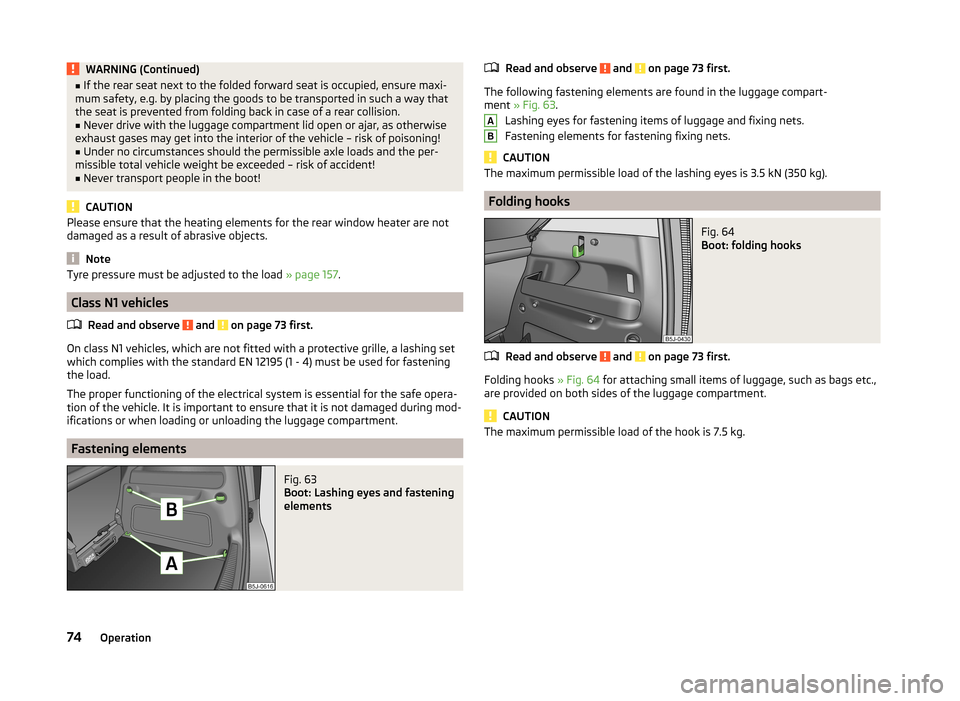
WARNING (Continued)■If the rear seat next to the folded forward seat is occupied, ensure maxi-
mum safety, e.g. by placing the goods to be transported in such a way that
the seat is prevented from folding back in case of a rear collision.■
Never drive with the luggage compartment lid open or ajar, as otherwise
exhaust gases may get into the interior of the vehicle – risk of poisoning!
■
Under no circumstances should the permissible axle loads and the per-
missible total vehicle weight be exceeded – risk of accident!
■
Never transport people in the boot!
CAUTION
Please ensure that the heating elements for the rear window heater are not
damaged as a result of abrasive objects.
Note
Tyre pressure must be adjusted to the load » page 157.
Class N1 vehicles
Read and observe
and on page 73 first.
On class N1 vehicles, which are not fitted with a protective grille, a lashing set
which complies with the standard EN 12195 (1 - 4) must be used for fastening
the load.
The proper functioning of the electrical system is essential for the safe opera-
tion of the vehicle. It is important to ensure that it is not damaged during mod-
ifications or when loading or unloading the luggage compartment.
Fastening elements
Fig. 63
Boot: Lashing eyes and fastening
elements
Read and observe and on page 73 first.
The following fastening elements are found in the luggage compart-
ment » Fig. 63 .
Lashing eyes for fastening items of luggage and fixing nets.
Fastening elements for fastening fixing nets.
CAUTION
The maximum permissible load of the lashing eyes is 3.5 kN (350 kg).
Folding hooks
Fig. 64
Boot: folding hooks
Read and observe and on page 73 first.
Folding hooks » Fig. 64 for attaching small items of luggage, such as bags etc.,
are provided on both sides of the luggage compartment.
CAUTION
The maximum permissible load of the hook is 7.5 kg.AB74Operation
Page 78 of 204

Fixing netsFig. 65
Fixing net: double horizontal pocket, floor fixing net/double verti-
cal pockets
Read and observe
and on page 73 first.
Fixing examples of the fixing net as a double horizontal pocket, floor fixing
net » Fig. 65 -
and double vertical pockets
» Fig. 65 -
.
WARNINGDo not exceed the maximum permissible load of the fixing nets. Heavy ob-
jects are not secured sufficiently – risk of injury!
CAUTION
■ The maximum permissible load of the fixing nets is 1.5 kg.■Do not place any sharp objects in the nets – risk of net damage.
Fixing floor covering of the luggage compartment
Read and observe
and on page 73 first.
You can fix the raised floor cover between the backrests and the luggage com-partment cover, if one needs to reach the spare wheel.
Boot coverFig. 66
Removing the luggage compartment cover/luggage compartment
cover in the lower position
Read and observe
and on page 73 first.
The boot cover can be removed if you wish to transport bulky goods.
›
Unhook support straps
1
» Fig. 66 .
›
Fold the luggage compartment cover forwards a little.
›
Remove the cover from the holders
2
by pulling towards the rear, or by
lightly knocking on the underside of the cover in the area between the hold-
ers.
›
To reinstall, first of all push the luggage compartment cover into the holders
2
and then hook the support straps
1
on the boot lid.
The luggage compartment cover can also be fitted in the lower position on the
supporting elements » Fig. 66 -
.
In this position you can store smaller objects up on the luggage compartment
cover up to a total weight of 2.5 kg.
WARNINGNo objects should be placed on the boot cover, the vehicle occupants could
be endangered if there is sudden braking or the vehicle collides with some-
thing.
CAUTION
Please ensure that the heating elements for the rear window heater are not
damaged as a result of objects placed in this area. 75Seats and stowing
Page 79 of 204
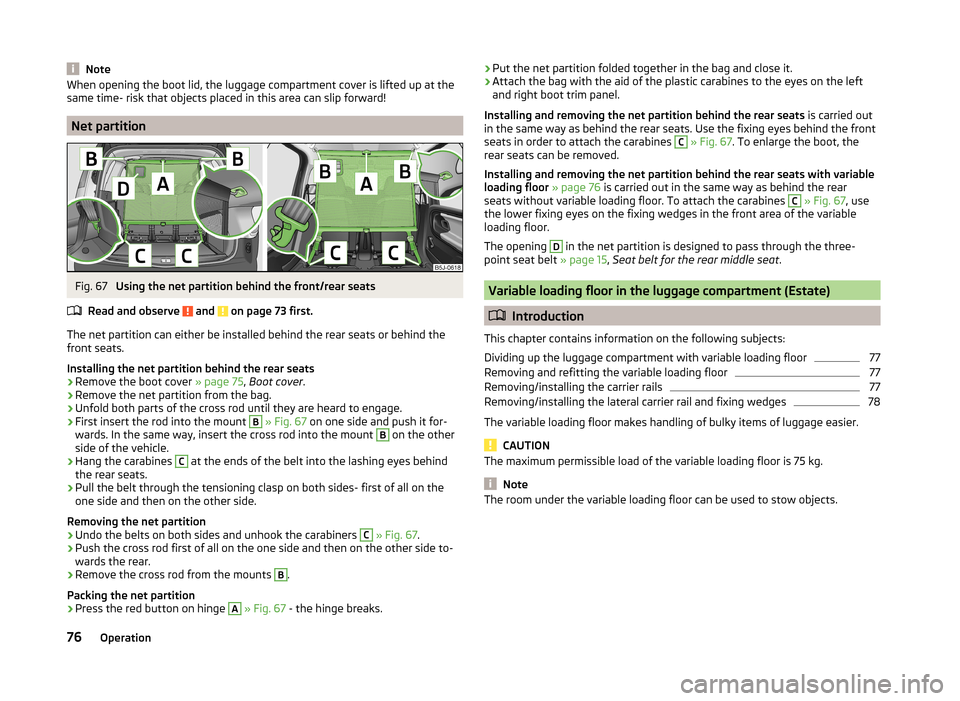
NoteWhen opening the boot lid, the luggage compartment cover is lifted up at the
same time- risk that objects placed in this area can slip forward!
Net partition
Fig. 67
Using the net partition behind the front/rear seats
Read and observe
and on page 73 first.
The net partition can either be installed behind the rear seats or behind the front seats.
Installing the net partition behind the rear seats
›
Remove the boot cover » page 75, Boot cover .
›
Remove the net partition from the bag.
›
Unfold both parts of the cross rod until they are heard to engage.
›
First insert the rod into the mount
B
» Fig. 67 on one side and push it for-
wards. In the same way, insert the cross rod into the mount
B
on the other
side of the vehicle.
›
Hang the carabines
C
at the ends of the belt into the lashing eyes behind
the rear seats.
›
Pull the belt through the tensioning clasp on both sides- first of all on the
one side and then on the other side.
Removing the net partition
›
Undo the belts on both sides and unhook the carabiners
C
» Fig. 67 .
›
Push the cross rod first of all on the one side and then on the other side to-
wards the rear.
›
Remove the cross rod from the mounts
B
.
Packing the net partition
›
Press the red button on hinge
A
» Fig. 67 - the hinge breaks.
›Put the net partition folded together in the bag and close it.›Attach the bag with the aid of the plastic carabines to the eyes on the left
and right boot trim panel.
Installing and removing the net partition behind the rear seats is carried out
in the same way as behind the rear seats. Use the fixing eyes behind the front
seats in order to attach the carabines C
» Fig. 67 . To enlarge the boot, the
rear seats can be removed.
Installing and removing the net partition behind the rear seats with variable
loading floor » page 76 is carried out in the same way as behind the rear
seats without variable loading floor. To attach the carabines
C
» Fig. 67 , use
the lower fixing eyes on the fixing wedges in the front area of the variable
loading floor.
The opening
D
in the net partition is designed to pass through the three-
point seat belt » page 15, Seat belt for the rear middle seat .
Variable loading floor in the luggage compartment (Estate)
Introduction
This chapter contains information on the following subjects:
Dividing up the luggage compartment with variable loading floor
77
Removing and refitting the variable loading floor
77
Removing/installing the carrier rails
77
Removing/installing the lateral carrier rail and fixing wedges
78
The variable loading floor makes handling of bulky items of luggage easier.
CAUTION
The maximum permissible load of the variable loading floor is 75 kg.
Note
The room under the variable loading floor can be used to stow objects.76Operation
Page 80 of 204
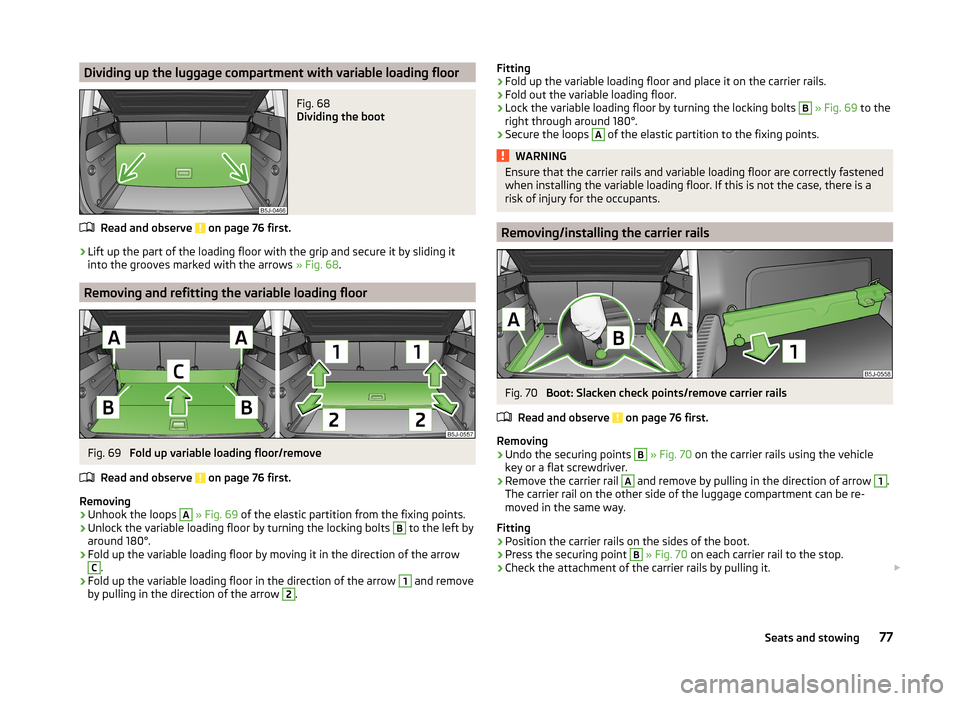
Dividing up the luggage compartment with variable loading floorFig. 68
Dividing the boot
Read and observe on page 76 first.
›
Lift up the part of the loading floor with the grip and secure it by sliding it
into the grooves marked with the arrows » Fig. 68.
Removing and refitting the variable loading floor
Fig. 69
Fold up variable loading floor/remove
Read and observe
on page 76 first.
Removing
›
Unhook the loops
A
» Fig. 69 of the elastic partition from the fixing points.
›
Unlock the variable loading floor by turning the locking bolts
B
to the left by
around 180°.
›
Fold up the variable loading floor by moving it in the direction of the arrow
C
.
›
Fold up the variable loading floor in the direction of the arrow
1
and remove
by pulling in the direction of the arrow
2
.
Fitting›Fold up the variable loading floor and place it on the carrier rails.›
Fold out the variable loading floor.
›
Lock the variable loading floor by turning the locking bolts
B
» Fig. 69 to the
right through around 180°.
›
Secure the loops
A
of the elastic partition to the fixing points.
WARNINGEnsure that the carrier rails and variable loading floor are correctly fastened
when installing the variable loading floor. If this is not the case, there is a
risk of injury for the occupants.
Removing/installing the carrier rails
Fig. 70
Boot: Slacken check points/remove carrier rails
Read and observe
on page 76 first.
Removing
›
Undo the securing points
B
» Fig. 70 on the carrier rails using the vehicle
key or a flat screwdriver.
›
Remove the carrier rail
A
and remove by pulling in the direction of arrow
1
.
The carrier rail on the other side of the luggage compartment can be re-
moved in the same way.
Fitting
›
Position the carrier rails on the sides of the boot.
›
Press the securing point
B
» Fig. 70 on each carrier rail to the stop.
›
Check the attachment of the carrier rails by pulling it.
77Seats and stowing